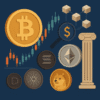Ripple (XRP) Shows Signs of Potential Breakout Amid Market Uncertainty
Ripple (XRP) is making steady progress, supported by consistent interest in the token, particularly in the derivatives market. A slight increase of over 1% on Tuesday has kept the token around $2.28, offering technical signals of a potential 18% breakout above an inverse head and shoulders (H&S) pattern.
Market Overview: Can XRP Extend Its Recovery?
Global markets are facing renewed uncertainty surrounding U.S. tariff policy. With the U.S. President’s tariff pause scheduled to end on Wednesday, followed by the implementation of higher tariffs on August 1, volatility could impact risk assets like XRP.
According to QCP Capital, only one trade agreement has been finalized out of 195 potential trading partners, and 14 new trade letters have been sent with rates ranging from 25% to 40%. The coming weeks warrant close monitoring.
“Japan and South Korea are facing tariffs of 25%, potentially higher. Markets remain resilient, relying on Trump’s usual delay game. But if the tariffs take effect, serious headwinds to growth are expected,” QCP Capital stated in Tuesday’s market update.
Interest in XRP remains consistent, albeit gradually increasing, as reflected by the Open Interest (OI) in the futures market. Data from CoinGlass shows that the OI, representing the value of all futures and options contracts that have not been settled or closed, has risen to $4.93 billion after falling to $3.53 billion on June 23.
This increase in Open Interest indicates growing investor confidence, with traders betting on a potential price increase for XRP. A subsequent 120% surge in derivatives market volume to $10 billion signals increased market activity, often followed by a significant price increase.
Simultaneously, liquidations of long and short positions have been nearly at parity, around $5 million in the last 24 hours, indicating potential indecision in the market, which may lead to price consolidation in the coming sessions.
Technical Outlook: XRP’s Technical Structure Projects an 18% Breakout
XRP’s price is approaching a potential breakout from the inverse head and shoulders pattern, which could propel the cross-border money remittance token by approximately 18% to $2.76.
This bullish pattern signals a possible shift from the downtrend that has persisted since XRP reached its all-time high of $3.40 in January to an uptrend. Key elements of this pattern include a lower ‘head’ flanked by two higher ‘shoulders’ with resistance at the neckline at $2.33.
A breakout above the resistance could extend the uptrend by 18% to $2.76. This target represents the height of the pattern from the neckline to the head and is then extrapolated above the breakout point.
Traders should monitor the potential change in volume, with an increase likely to increase the probability of a sustained uptrend.
The Money Flow Index (MFI) indicator pointing upwards, slightly above the midline of 50, indicates a potential increase in risk sentiment. This tool tracks money flowing into or out of XRP, with a persistent increase signaling the possibility of bullish momentum.
Should XRP fail to break the pattern’s neckline resistance at $2.33, a consolidation phase could follow, with support provided by the 50-period exponential moving average (EMA), the 100-period EMA, and the 200-period EMA, all situated between $2.20 and $2.22 on the 8-hour chart.
SEC vs. Ripple Lawsuit – Key Takeaways
According to a court ruling issued on July 14, the classification of XRP depends on the transaction:
- For institutional investors or over-the-counter (OTC) sales, XRP is considered a security.
- For retail investors who purchased the token through programmatic sales on exchanges, on-demand liquidity services, and other platforms, XRP is not a security.
The Securities and Exchange Commission (SEC) accused Ripple and its executives of raising over $1.3 billion through an unregistered asset offering of the XRP token.
While the judge ruled that programmatic sales are not considered securities, sales of XRP tokens to institutional investors are investment contracts. In the latter case, Ripple violated U.S. securities law and will continue to litigate the approximately $729 million it received under written contracts.
The ruling offers a partial victory for both Ripple and the SEC, depending on the perspective.
Ripple secured a significant win as programmatic sales are not considered securities, which could bode well for the broader cryptocurrency sector, as most assets targeted by the SEC are managed by decentralized entities that sold their tokens primarily to retail investors through exchange platforms, experts say.
However, the ruling does not significantly clarify what makes a digital asset a security, leaving uncertainty about whether this lawsuit will set a precedent for other open cases involving dozens of digital assets. Issues such as the appropriate degree of decentralization to avoid the “security” label and where to draw the line between institutional and programmatic sales are likely to persist.
The SEC has intensified its enforcement actions toward the blockchain and digital asset sector, filing charges against platforms like Coinbase and Binance for alleged violations of U.S. securities law. The SEC asserts that most crypto assets are securities and, therefore, subject to strict regulation.
While defendants may use parts of the Ripple ruling to their advantage, the SEC may also find reasons to maintain its current strategy of regulation through enforcement.
The court decision is a partial summary judgment. The ruling can be appealed once a final judgment is issued or if the judge permits it beforehand. The case is in a pre-trial phase, where both Ripple and the SEC still have the possibility of reaching a settlement.
Stay ahead of the curve in the fast-paced crypto world – explore the latest updates and trends at Cryptonewsfeeds.com.










